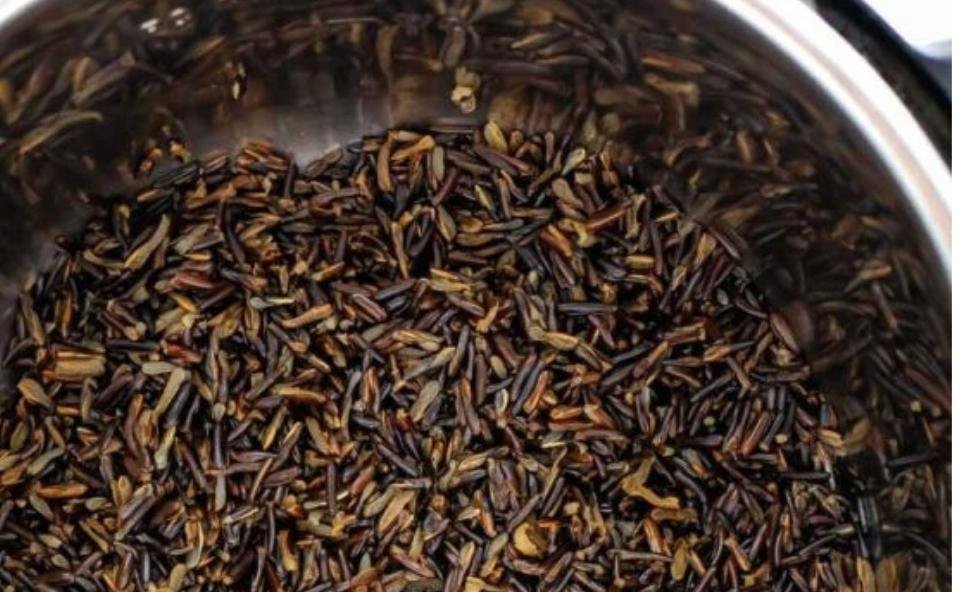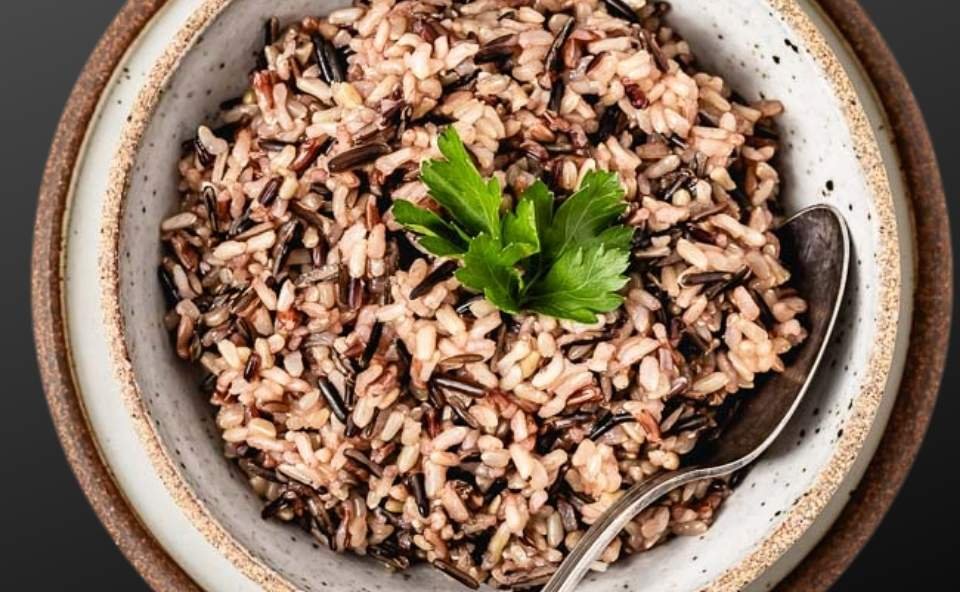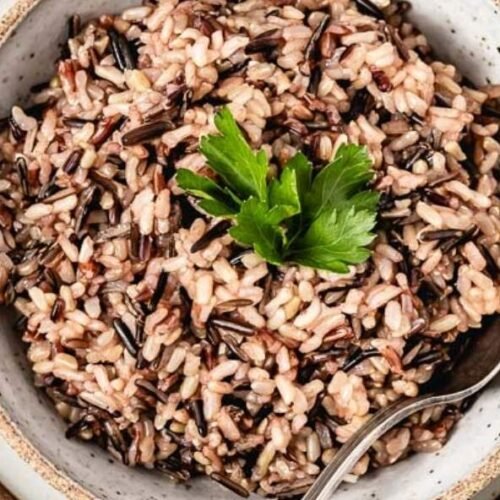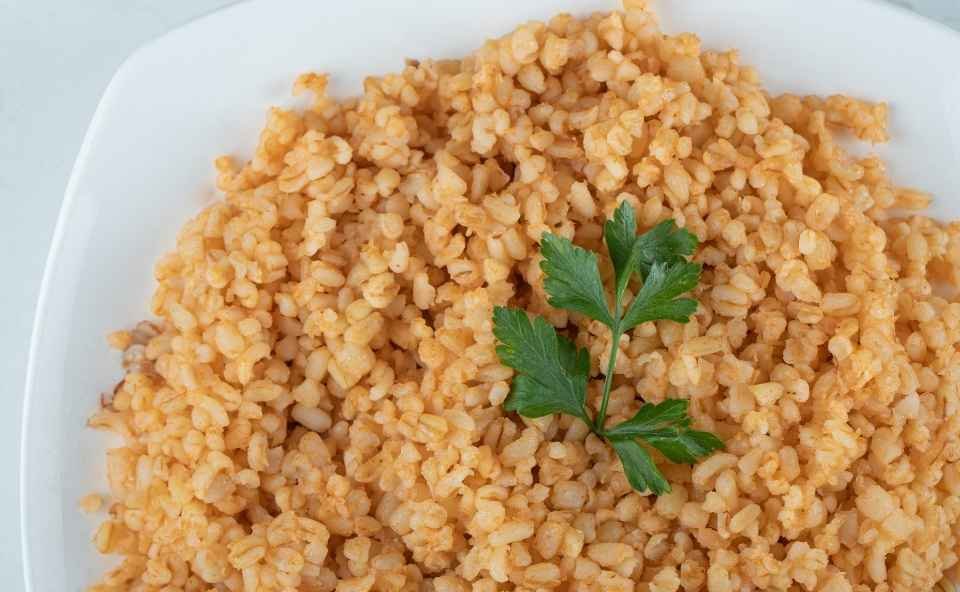I love cooking wild rice in my cooker because it’s super easy and convenient. With the right water ratio, you get perfectly fluffy and tender grains every time—no stress, no mess. Unlike cooking on the stove, where I’ve forgotten a pot and had a sticky nightmare to scrape off, the rice cooker makes it nearly impossible to burn rice.
Wild rice is packed with protein, fiber, and essential minerals, making it a healthy addition to any meal. I like to get creative with recipes, sometimes adding cilantro, lime, or coconut milk for a tasty twist.
Just follow the instructions, and you’re guaranteed perfect results.
Buying wild rice from the bulk section of the grocery store is way cheaper than prepackaged options. Cooking a big bowl in the cooker means leftovers for easy storage and future meals. It’s so versatile, and I can’t imagine my kitchen without it!
Step by Step Guide
Cooking wild rice in a rice cooker has become one of my favorite ways to prepare this flavorful and nutritious dish. It’s super easy and stress-free, giving me perfect fluffy and tender grains every time. Whether I’m making a quick weeknight meal or prepping for a family gathering, this method always delivers!

1. Preparing the Rice Cooker
I start by spraying the bottom of the rice cooker bowl lightly with cooking spray to prevent sticking. It makes cleanup so much easier.
Then, I rinse the uncooked wild rice grains in a fine-mesh sieve under cool, clean water. This step removes dust and debris from storage and helps the grains cook evenly.
The best part is you can skip soaking—the rice cooker handles it perfectly!
2. Adding Ingredients
I add 1 cup of wild rice and 2 cups of water or broth to the inner pot. Sometimes, I use broth for an extra kick of flavor.
For even more taste, I add a pinch of salt, a dab of butter or a drizzle of olive oil. It makes the wild rice so rich and savory.
After that, I close the lid securely.
3. Cooking the Wild Rice
I select the appropriate setting on my rice cooker: If it has a wild rice or brown rice setting, I use that. For my basic rice cooker, I just press the button and let it work its magic.
It usually takes 45 to 50 minutes and automatically shuts off when complete—so no worries about overcooking!
4. Resting and Fluffing
Once the cooking cycle is done, I let the wild rice rest in the rice cooker for another 10 to 15 minutes to allow steam absorption.
Then, I gently open the lid and fluff the rice with a fork. The texture is always perfectly fluffy and tender.
5. Serving Suggestions
I love serving wild rice as a side dish with curries, stews, and soups or even as a base for salads. It’s so versatile and healthy—packed with protein, fiber, and essential minerals.
This method is a guaranteed way to enjoy wild rice every time—no more worrying about burnt or forgotten pots!Using a rice cooker to make wild rice has truly changed the way I cook. It’s a simple and foolproof approach that brings out the best in this nutty, flavorful grain.

Using Wild Rice Blends in a Rice Cooker
I’ve found that cooking wild rice in a cooker can be a great way to get perfect results every time. When using a wild rice blend or mix with varieties like brown or red rice, the best ratio is 2 cups of water for every 1 cup of rice.
If the rice feels firm after cooking, I usually add 2-3 Tbsp of water and let it cook a bit longer. This small adjustment can make a big difference, especially when using a medley with different ingredients.
For blends with grains like quinoa or barley, I prefer to adjust the water ratio slightly based on the brand. A good starting point is 1.5-1.8 cups of water per 1 cup of blend.
The unique composition of species like Zizania palustris, Zizania aquatica, Zizania texana, or Zizania latifolia can affect cooking time.
I always follow the instructions provided by the brand for the best results, and this approach has worked well for me!
Smart Tips for Perfect Wild Rice
At first, I struggled with getting the texture just right, but after experimenting, I found some smart tips that make a big difference. If you follow these steps, your wild rice will turn out delicious every time.
- The right ratio is key—1 cup of uncooked rice with 2 cups of liquid gives a little over 3 cups of cooked rice.
- It takes about 1 hour to cook, and since wild rice is naturally chewier than white or brown rice, don’t think it’s undercooked too soon.
- If it’s not soft enough at the end of cooking, simply add 2-3 tablespoons of liquid and cook longer until it reaches your desired texture.
- To prevent the rice from sticking, I always lightly grease the insert of my rice cooker—it makes cleanup so much easier!
- If I’m short on time, I sometimes use an Instant Pot instead of a pot on the stove, which speeds up the process while still keeping the flavor intact.
Once I started following these steps, cooking wild rice became effortless. Whether I’m making it as a side dish or adding it to a hearty meal, it turns out perfect every time!
Nutrition
It’s a superfood that is gluten-free, high in protein, and packed with antioxidants. Whether I’m making a quick side dish or using it as a base for a meal, I know I’m getting something both delicious and nourishing.
Below is a detailed breakdown of its nutritional content per serving size of cooked one cup wild rice.
| Nutrient | Amount | % Daily Value |
|---|---|---|
| Calories | 166 | - |
| Carbohydrates | 35g | 12% |
| Fiber | 3g | 12% |
| Protein | 6.5g | 13% |
| Fat | 0.6g | 1% |
| Saturated Fat | 0.1g | 0% |
| Polyunsaturated Fat | 0.3g | - |
| Monounsaturated Fat | 0.1g | - |
| Sugar | 1g | 1% |
| Sodium | 4mg | 0% |
| Potassium | 43mg | 1% |
| Calcium | 5mg | 0% |
| Iron | 0.9% | 5% |
| Vitamin A | 0IU | 0% |
| Based on 2000 Calorie Diet |
Reference: For detailed nutritional info on cooked wild rice, check MooseLakeWildRice.
f you haven’t tried it yet, you’re missing out on a truly satisfying and nutritious addition to your meals!
Storing Your Wild Rice
After cooking your wild rice, I always let it cool completely on a baking sheet or a large plate at room temperature. This step really helps prevent excess moisture from building up.
Once cooled, I transfer it to an airtight storage container or a resealable plastic bag and pop it in the fridge. It can last about 3-5 days, and when I need it again, I simply reheat it in the microwave or on the stovetop.
If you want to store it longer, I freeze it. Just follow these steps: place it in a container and stick it in the freezer. It lasts up to 6 months. When I’m ready to use it, I let it thaw in the refrigerator overnight, and then reheat it for a quick meal.
For better results, I use reusable ziplock bags to store it in the freezer. I make sure the rice is completely cooled before placing it in the freezer, which helps prevent freezer burn.
If I forget to thaw it, I just defrost it in the microwave with a little water, and it comes out soft and fluffy.
Delicious Dishes to Pair With Wild Rice
When cooking wild rice, I’ve discovered that it can be a perfect base for many delicious dishes. I love how wild rice is versatile and pairs well with so many flavors. Here are a few ideas on what to serve with it:
- Cranberry Pecan Salad: This is a favorite of mine. I mix cooked wild rice with dried cranberries, toasted pecans, diced apples, and chopped fresh parsley. For dressing, I whip up a simple vinaigrette with olive oil, lemon juice, Dijon mustard, and a bit of maple syrup. The sweet and savory combination is just perfect!
- Mung Bean Curry: For a rich and creamy dish, try this dish. The spices mix perfectly with wild rice cooked in a rice cooker, creating a hearty and satisfying meal. It’s a great vegetarian choice that’s both comforting and flavorful.
- Stuffed Bell Peppers: Stuffed bell peppers are always a hit in my house. I stuff them with black beans, corn, diced tomatoes, and plenty of spices. After baking, they come out tender and colorful, making for a nutritious and filling main course.
- Mushroom Stroganoff: For a cozy, creamy dish, I make mushroom stroganoff by sautéing shiitake, cremini, or Portobello mushrooms with onions and garlic. I then add vegetable broth, non-dairy milk, and the perfect seasonings to make a creamy sauce. This pairs wonderfully with wild rice.
- Vegan Wild Rice Soup: When I’m in the mood for a comforting soup, I make vegan wild rice soup. It’s creamy, satisfying, and the perfect way to use up leftover wild rice.
- Roasted Root Vegetables: Roasting carrots, sweet potatoes, and beets fills my kitchen with the best aroma. Their natural sweetness and crispy edges pair perfectly with wild rice for a cozy, wholesome meal.
These dishes prove that wild rice is incredibly versatile. Whether you’re in the mood for something fresh like a salad or cozy like a soup, it’s the perfect addition to any meal.
Other Rice Varieties & How They Are Cooked
If you’re curious about how I cook different rice varieties, check out the links below to see the methods I use!
Recipe Card

How to Cook Wild Rice in a Rice Cooker
Equipment
- 1 Rice Cooker
- 1 Fine-Mesh Sieve
Ingredients
- 2 Cup Wild Rice
- 4 Cup Water
- 1/2 Tbsp Salt Optional
- 1 Tbsp Olive oil Optional
Instructions
- Preparing the Rice Cooker: Spray the rice cooker’s bottom with cooking spray to prevent sticking. Rinse the wild rice under cool water in a fine-mesh sieve.
- Adding Ingredients: Add 1 cup of wild rice and 2 cups of water (or broth). Optionally, add salt, butter, or olive oil for flavor.
- Cooking the Wild Rice: Set the rice cooker to the wild rice or brown rice setting, or press the cook button if using a basic rice cooker. Let it cook for 45-50 minutes.
- Resting and Fluffing: Let the rice rest for 10-15 minutes in the cooker. Fluff with a fork for perfectly tender rice.
- Serving Suggestions: Serve as a side with curries, stews, or soups, or as a base for salads.
Notes
- Adjust water for different blends of wild rice, such as adding 2-3 Tbsp more water if needed for specific blends.
- Wild rice can be stored in the fridge for 3-5 days or frozen for up to 6 months.
- Serve with dishes like cranberry pecan salad, mung bean curry, or stuffed bell peppers for a complete meal.

Hi, I’m the voice behind The Bean Bite — someone who’s genuinely obsessed with beans! What started as a simple love for homemade lentil stew turned into a journey of discovering bean varieties, cooking tips, and their amazing health benefits. This site is my way of sharing that joy with you — one bean at a time.



